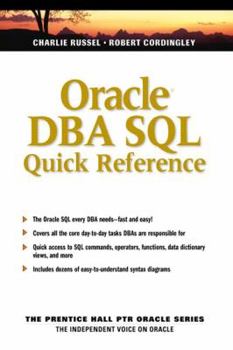Oracle DBA SQL Quick Reference
A quick reference guide to Oracle DBA SQL. The text covers the core of the day-to-day tasks most DBAs are responsible for and provides syntax diagrams and SQL commands in alphabetical order. This description may be from another edition of this product.
Format:Paperback
Language:English
ISBN:0131403036
ISBN13:9780131403031
Release Date:January 2003
Publisher:Prentice Hall PTR
Length:529 Pages
Weight:1.50 lbs.
Dimensions:1.0" x 6.1" x 9.1"
Customer Reviews
2 ratings
Prashant Dangash
Published by Thriftbooks.com User , 19 years ago
The book is truly what the title suggest - a quick reference guide. It makes an Oracle user's life easy by putting SQL commands in a clear concise manner. If you are an Oracle user, who uses Oracle extensively using SQL command interface and not the GUI, this book is for you.
Clear and simple to use
Published by Thriftbooks.com User , 20 years ago
Remember the early days of Oracle's products? Now we've reached the heights of Oracle 9i. How things are grown. The multiple table joins; the many obscure syntactical variants added by what are now centuries of person years of coding. Perhaps it is inevitable that any successful software will continually add refinements that increase its capabilities, but usually this is done at a concomitant loss of simplicity. Typically you as a database administrator will rarely use most features. But how to find the occasional rarity that you need, and have forgotten (or perhaps never knew)?By definition, the vendor's manuals are authoritative. But often these fall short in usability or pedagogy. (Oracle is by no means alone in this.) So here, Russel and Cordingley give you an independent, simple index into 9i. A quick perusal shows no index. But a second look shows that the entire book is really a graphical index into, and a refresher of, the command syntax. Like conventional indices, the book does not attempt to explain its entries. For example, on page 146, we see a graph for "add hash substitution". They assume you know what this means, but that you need a quick reminder of HOW to invoke it. Given that you have the database and its online help accessible (otherwise why would you need this book?), this is a fair assumption. Clearly, you can consult the online or hardcopy documentation for more information. The stress in the book is on simplicity. There is a little irony here. A database is a means whereby you can store data in a silo and easily get summaries and subsets ("views") of it. When you strip away the technical jargon, every database package aspires to this. If you regard the commands and capabilities of a database as data (or metadata), then you cannot usually change these. But how do you get summaries and views of THIS data? That is what the vendor's online help and documentation is all about. The irony about this book is not that it was written, but that it was not written by Oracle. The vendor's raison d'etre is to provide tools for access to information. But here, others have seen a need to write another tool to get at the vendor's own data.





